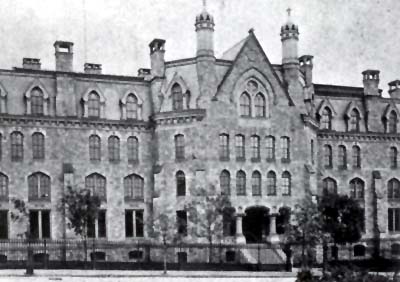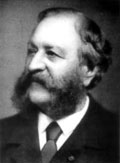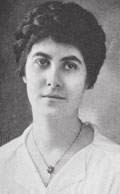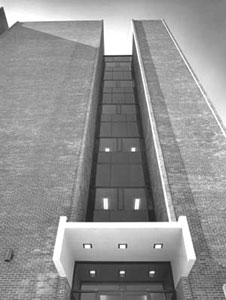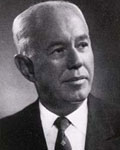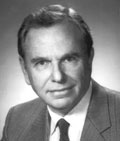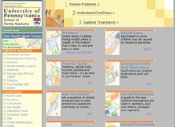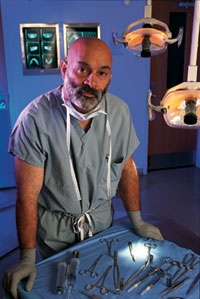
|
Highlights of the School of Dental Medicine's 125 Years: Landmarks of Excellence Leadership and Innovation
1878 The School of Dental Medicine was founded as the Dental Department by the Trustees of the University. This was the third university-affiliated dental school to be established in the nation (after Harvard University and University of Michigan). The Dental Department opened in Medical Hall, renamed Logan Hall in 1905. Dr. Charles J. Essig, the Dean of the Pennsylvania College of Dental Surgery, was asked to join the University of Pennsylvania and develop the Dental Department. He led the Department as the Secretary of the Faculty from 1878-1883. The original class was made up of just 53 students, many of whom had been instructed by Dr. Essig at the Pennsylvania College of Dental Surgery. By the 1880-1881 term, student enrollment had grown to 77, including students from around the country, Europe, and South America. Several of these students went on to become instructors at the School. 1881 Dr. James Brister, an 1881 graduate of the Dental School, is the first known minority graduate of the University. The James Brister Society has been named in his honor.
1896 (Pearl) Zane Grey (at right), Class of 1896, and renowned author of western novels, opened a dental office in New York City, but preferred outdoor activities and writing to dentistry. Dr. Grey's first trip west to the Arizona Territories launched his writing career and he proceeded to write 26 novels between 1910 and 1962. 1897 Dental Hall, located at 33rd and Locust Streets, was completed, becoming the new home to the Dental Department. Designed by architect Edgar Seeler, the total cost of the new building was approximately $150,000. The interior included a large clinical operating room, and labs for prosthetics, crown and bridge, metallurgy, modeling, and histological and bacteriological. A 500-seat lecture amphitheatre, dental museum, and library completed the building. Dean Edward Kirk referred to the radical change in the Dental Department due to the new building as a "renaissance rather than a development." The building is now known as Hayden Hall, on Smith Walk, opposite the Towne Building.
Thomas W. Evans Dental Institute, graduate room, circa 1915.
1915 The Thomas W. Evans Building dedication. This collegiate gothic, Tudor-style building, was considered the most advanced dental teaching facility in the nation when completed. It helped to establish new standards for teaching clinical dentistry in the U.S., and today, the Evans Building remains the site of most of the School's classroom instruction as well as much of its clinical training. The School's earliest benefactor, Thomas W. Evans (at right), built a prestigious dental career on the other side of the Atlantic, becoming the dental surgeon and confidant of Napoleon III. Yet, he never forgot his native Philadelphia, leaving his fortune to create a dental institute and museum here that in his words would be "not inferior to any already established." His bequest would become one with the University of Pennsylvania, resulting in the School of Dental Medicine's Thomas W. Evans Museum and Dental Institute.
1969 The Leon Levy Center for Oral Health Research (above) dedication. The Levy Center played a pivotal role in the growth of Penn Dental, providing a home for its basic science faculty and the facilities needed to support a world-class research program. Penn remains one of only a few dental schools in the country with its own basic science faculty and a leader in oral health sciences research. The largess of Dr. Leon Levy, (at right) a Penn Dental graduate of the Class of 1915, made possible the Leon Levy Center for Oral Health Research, the hub of the School's research activities. While he spent most of his professional life in the communications field (buying WCAU radio in 1925 and helping to form the Columbia Broadcasting System, now CBS), he remained an avid supporter of Penn Dental and the importance of its research efforts. In addition to providing funding for the Levy Center, Dr. Levy funded the School's Leon Levy Library and was also responsible for the establishment of the Levy Department of Dental Medicine at HUP.
1976 Dr. Phoebe Leboy, (at left) Professor of Biochemistry, became the first woman to achieve the rank of full professor in the Dental School. 1981 The W.D. Miller Clinical Research Center (CRC) was established to develop a program that would foster interdisciplinary clinical research. This was the first dental clinical research center that was federally funded.
1986 The Microbiological Testing Laboratory, the first clinical oral microbiological lab in the world, was formed. The Lab identifies subgingival plaque samples for aggressive and chronic periodontitis and endodontic samples for root canal and periapical infections.
1997 The SDM was designated a World Health Organization Collaborating Center for Oral Infectious Diseases: Education, Research, and Care. The School was designated as a test site for DenX's DentSim virtual reality unit. DentSim simulates a complete patient in the form of a stylized mannequin and enables students to learn specific procedures in a preclinical setting. A dental student, and Dr. Judith Buchanan, associate dean of academic affairs, explore DentSim (right).
Dr. Robert Schattner, Penn alumnus, in front of the new Robert Schattner Center, which was dedicated November 1. Its state-of-the-art facilities and unifying design have created an environment for promoting interdisciplinary initiatives and reaching new levels of discovery and achievement in oral health science and dental education, while better serving the community. Its features include: • Oral
and Maxillofacial Surgery Clinic (first floor) The new building has unified the Penn Dental campus. As the main entrance to the School, it connects the three buildings of the Penn Dental campus, improving the interaction of all members of the SDM community and making the School more accessible to patients and other visitors.
2002 Penn Dental currently has 16 women among its standing faculty and the incoming Class of 2002 is 47% women. The Schattner Center dedication. The School's 70,000-square-foot clinical care, education, and research facility will provide Penn Dental with the resources needed to maintain excellence, leadership, and innovation in advancing its mission of education, research, and patient care. The School launched its 125th Anniversary celebration on October 31 with a special Dental Leadership Forum that brought key leaders in dental education, research, and organized dentistry to SDM. Senator Arlen Specter addressed dental school deans from the US and Canada at the Forum, held October 31 in the University Museum. University Trustees, Dental Overseers and major donors gathered November 1 for a luncheon dedication of the Schattner Center, held in the Center's atrium.
Dr.
Raymond Fonseca (left) has been dean of the school since
1989 and is also professor of oral surgery/pharmacology. Under Dr.
Fonseca's leadership, the Dental House, a living and learning community
for Penn Dental students, was established a few blocks from the
School providing modern living space and a full pre-clinical dental
laboratory. He has expanded the faculty practice to six locations
throughout the area.
|
|
